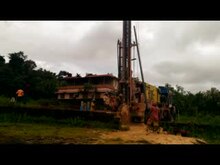Tube well
This article relies largely or entirely on a single source. (October 2020) |



A tube well is a type of water well in which a long, 100–200 millimetres (3.9–7.9 in)-wide, stainless steel tube or pipe is bored into an underground aquifer. The lower end is fitted with a strainer, and a pump lifts water for irrigation. The required depth of the well depends on the depth of the water table.

Temporary reservoir[]
A small reservoir of water is made at the outlet of the tube well. This reservoir is used for different usage of water by the local population.
Casing[]
The tube well casing houses the inlet, cylinder, piston valves and rising main of a "down-the-hole" type hand pump. Casing to support the external surfaces of the borehole against collapse may be needed, either temporarily or permanently, and is often made of PVC pipe, which is both cheap and inert.
Seepage down the tube well bore is prevented by the sanitary seal. Seepage from the ground above the aquifer is excluded by the lengths of plain casing. Water to be pumped is admitted through slots in the lower lengths of casing.
Water abstracted from aquifers in relatively soft ground usually contains sand or silt particles, which are liable to cause rapid wear to pump valves and cylinders (and dissatisfaction among consumers). Methods of preventing these particles from reaching the pump are of two general types, screening and sand/gravel packing.
- Screening
In the simplest devices, slots are simply cut in the casing. More elaborate compact screens are available commercially; some can be bolted on to pump inlets. Materials used include woven wire and man-made fabric; the latter can be wrapped around the pump inlet assembly.
- Sand/gravel packing
Graded sand and gravel may be placed from[clarification needed] the top of the borehole. More compact, pre-bonded, packs of sand and/or gravel are available commercially; some of these can also form part of the pump inlet assembly. Sand and/or gravel packing is meant to eliminate particles from the water before they reach the screen which they would otherwise have passed through.
Ground water safety[]
The introduction of tube wells has led to major arsenic poisoning in Bangladesh.[1] High concentrations of arsenic occur naturally in the soil in some areas of Bangladesh.
Advantages of tube well irrigation[]
- Groundwater is easily available.
- The water table is fairly close to the surface.
- Able to irrigate a much larger area.
- More reliable during periods of drought when surface water dries up.
- Suitable for small holdings.
References[]
- ^ Walsh, Bryan (2010-06-19). "Study Says Arsenic Poisons Millions in Bangladesh—But They're Not the Only Ones". Time. ISSN 0040-781X. Retrieved 2021-10-08.
- Water wells
